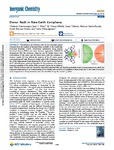Donor Radii in Rare-Earth Complexes

Use este enlace para citar
http://hdl.handle.net/2183/39793
Excepto si se señala otra cosa, la licencia del ítem se describe como Copyright © 2023 The Authors. Published by American Chemical Society. This publication is licensed under CC-BY 4.0 (https://creativecommons.org/licenses/by/4.0/)
Colecciones
- Investigación (FCIE) [1228]
Metadatos
Mostrar el registro completo del ítemTítulo
Donor Radii in Rare-Earth ComplexesAutor(es)
Fecha
2023-10-02Cita bibliográfica
Inorg. Chem. 2023, 62, 17030−17040
Resumen
[Abstract]: We present a set of donor radii for the rare-earth cations obtained from the analysis of structural data available in the Cambridge Structural Database (CSD). Theoretical calculations using density functional theory (DFT) and wave function approaches (NEVPT2) demonstrate that the Ln-donor distances can be broken down into contributions of the cation and the donor atom, with the minimum in electron density (ρ) that defines the position of (3,–1) critical points corresponding well with Shannon’s crystal radii (CR). Subsequent linear fits of the experimental bond distances for all rare earth cations (except Pm3+) afforded donor radii (rD) that allow for the prediction of Ln-donor distances regardless of the nature of the rare-earth cation and its oxidation state. This set of donor radii can be used to rationalize structural data and identify particularly weak or strong interactions, which has important implications in the understanding of the stability and reactivity of complexes of these metal ions. A few cases of incorrect atom assignments in X-ray structures were also identified using the derived rD values.
Palabras clave
Lanthanides
Metals
Reaction products
Donor atoms
Rare-Earth Complexes
Density functional theory
Positive ions
Rare earths
Wave functions
Metals
Reaction products
Donor atoms
Rare-Earth Complexes
Density functional theory
Positive ions
Rare earths
Wave functions
Versión del editor
Derechos
Copyright © 2023 The Authors. Published by American Chemical Society. This publication is licensed under CC-BY 4.0 (https://creativecommons.org/licenses/by/4.0/)
ISSN
1520-510X






